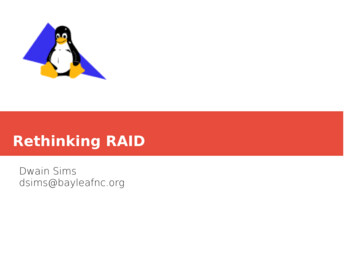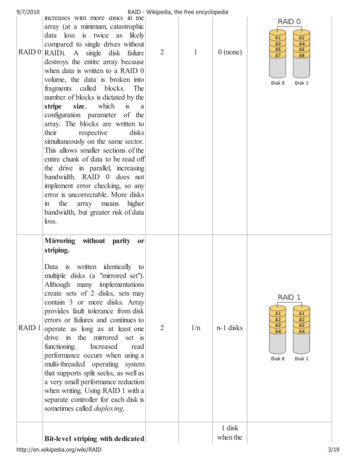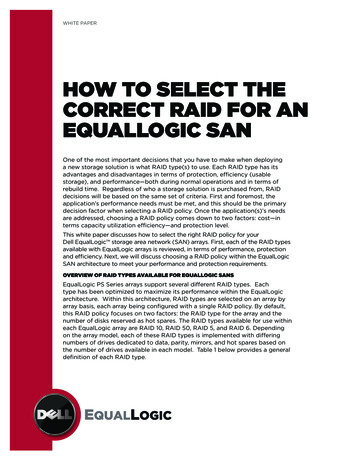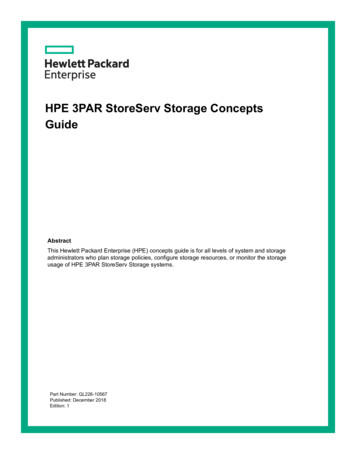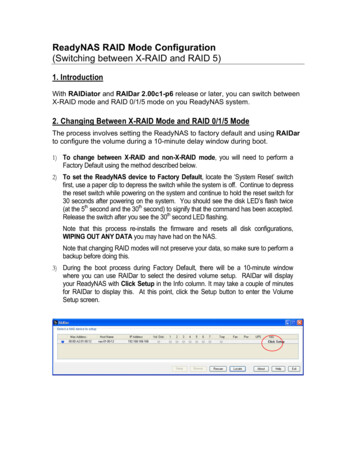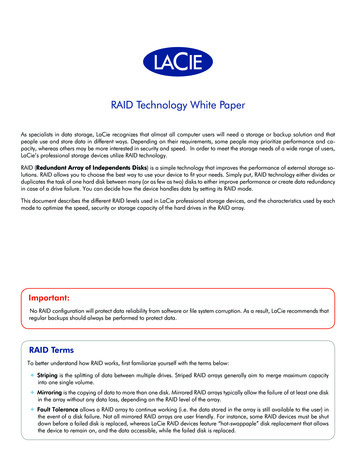
Transcription
RAID Technology White PaperAs specialists in data storage, LaCie recognizes that almost all computer users will need a storage or backup solution and thatpeople use and store data in different ways. Depending on their requirements, some people may prioritize performance and capacity, whereas others may be more interested in security and speed. In order to meet the storage needs of a wide range of users,LaCie’s professional storage devices utilize RAID technology.RAID (Redundant Array of Independents Disks) is a simple technology that improves the performance of external storage solutions. RAID allows you to choose the best way to use your device to fit your needs. Simply put, RAID technology either divides orduplicates the task of one hard disk between many (or as few as two) disks to either improve performance or create data redundancyin case of a drive failure. You can decide how the device handles data by setting its RAID mode.This document describes the different RAID levels used in LaCie professional storage devices, and the characteristics used by eachmode to optimize the speed, security or storage capacity of the hard drives in the RAID array.Important:No RAID configuration will protect data reliability from software or file system corruption. As a result, LaCie recommends thatregular backups should always be performed to protect data.RAID TermsTo better understand how RAID works, first familiarize yourself with the terms below: Striping is the splitting of data between multiple drives. Striped RAID arrays generally aim to merge maximum capacityinto one single volume. Mirroring is the copying of data to more than one disk. Mirrored RAID arrays typically allow the failure of at least one diskin the array without any data loss, depending on the RAID level of the array. Fault Tolerance allows a RAID array to continue working (i.e. the data stored in the array is still available to the user) inthe event of a disk failure. Not all mirrored RAID arrays are user friendly. For instance, some RAID devices must be shutdown before a failed disk is replaced, whereas LaCie RAID devices feature “hot-swappaple” disk replacement that allowsthe device to remain on, and the data accessible, while the failed disk is replaced.
LaCie RAID Technology White PaperStandard RAID levelsRAID 0RAID 0 (also called FAST mode in some LaCie devices), is the fastest RAID mode. Requiring at least 2 drives,RAID 0 stripes data onto each disk. The available capacities of each disk are added together so that one logicalvolume mounts on the computer.If one physical disk in the array fails, the data of all disks becomes inaccessible because parts of the data havebeen written to all disks.RAID 0ApplicationsRAID 0 is ideal for users who need maximumspeed and capacity. Video editors working withvery large files may use RAID 0 when editing multiple streams of video for optimal playback performance. A RAID 0 array is more suited for activelyworking with files (editing video, for example) andshould not be used as a single storage backupsolution or on mission critical systems.A1A2A3A4B1B2B3B4C1D1C2D2C3D3C4D4Disk 1Disk 2Disk 3Disk 4LaCie Products with RAID 0 LaCie 2big quadra LaCie 4big quadra LaCie big disk quadra (built-in)RAID 0 LaCie little big disk quadra (built-in) LaCie 5big networkRAID 1RAID 3How RAID 0 Capacity Is CalculatedRAID 3 SpareEach disk in a RAID 0 system should have thesame capacity.RAID 5Storage capacity in a RAID level 0 configurationis calculated by multiplying the number of drivesby the disk capacity, or C n*d, where:RAID 5 SpareRAID 6C available capacityn number of disksRAID 0 1d disk capacityRAID 10For example, in a RAID 0 array with four driveseach with a capacity of 1000GB, the total capacity of the array would be 4000GB:ConcatenationC (4*1000)JBODRAID SelectionPage 2
LaCie RAID Technology White PaperRAID 1RAID 1 (also called SAFE mode in some LaCie devices) is a secure RAID mode that requires at least 2 drivesand works with pairs of drives. One logical volume mounts on the computer and the combined availablecapacity of both drives is limited to the capacity of the lowest-capacity disk. If one physical disk fails, the datais available immediately on the second disk. No data is lost if one disk fails.RAID 1ApplicationsRAID 1 provides maximum data safety in theevent of a single disk failure, but because datais written twice, performance is reduced slightly when writing. RAID 1 is a good choice whensafety is more important than speed.LaCie Products with RAID 1 LaCie 2big quadraA1A1B1B1C1D1E1C1D1E1 LaCie 2big networkHow RAID 1 Capacity Is CalculatedEach disk in a RAID 1 system should have thesame capacity.RAID 0Storage capacity in a RAID level 1 configurationis calculated by multiplying the number of drivesby the disk capacity and dividing by 2, orRAID 1C n*d/2RAID 3RAID 3 SpareRAID 5RAID 5 SpareRAID 6where:C available capacityn number of disksd disk capacityFor example, in a RAID 1 array with four driveseach with a capacity of 1000GB, the total capacity of the array would be 2000GB:C (4*1000)/2RAID 0 1RAID 10ConcatenationJBODRAID SelectionPage 3
LaCie RAID Technology White PaperRAID 3RAID 3 uses byte-level striping with a dedicated parity disk (Disk 4 in the illustrations, right) so that one volumemounts on the computer. A RAID 3 array can tolerate a single disk failure without data loss. If one physical diskfails, the data from the failed disk can be rebuilt onto a replacement disk. If a second disk fails before data canbe rebuilt to a replacement drive, all data in the array will be lost.RAID 3ApplicationsRAID 3 provides good data safety for environments where long, sequential files are beingread, such as video files. Disk failure does notresult in a service interruption because data isread from parity blocks. RAID 3 is useful forpeople who need performance and constantaccess to their data, like video editors. RAID3 is not recommended for intensive use withnonsequential files because random read performance is hampered by the dedicated 2C5B3B6C3C6Bp(1-3)Bp(4-6)Cp(1-3)Cp(4-6)Disk 1Disk 2Disk 3Disk 4LaCie Products with RAID 3 LaCie 4big quadraHow RAID 3 Capacity Is CalculatedRAID 0RAID 1RAID 3RAID 3 SpareRAID 5RAID 5 SpareEach disk in a RAID 3 system should have thesame capacity.Storage capacity in a RAID level 3 configuration is calculated by subtracting the numberof drives by one and multiplying by the diskcapacity, orC (n-1)*dwhere:C available capacityn number of disksRAID 6RAID 0 1RAID 10Concatenationd disk capacityFor example, in a RAID 3 array with four driveseach with a capacity of 1000GB, the total capacity of the array would be 3000GB:C (4-1)*1000JBODRAID SelectionPage 4
LaCie RAID Technology White PaperRAID 3 SpareIn RAID 3 Spare, one disk in the array is left empty. If a drive in the array fails, the data from the failed disk isautomatically rebuilt to the empty or “spare” disk.RAID 3 SpareApplicationsIn RAID 3 Spare disk failure does not requireimmediate attention because the system rebuilds itself using the hot spare, but the faileddisk should be replaced as soon as possible.LaCie Products with RAID 3 Space LaCie 4big quadraHow RAID 3 Space Capacity Bp(1-2)Bp(3-4)Cp(1-2)Cp(3-4)SpareDisk 1Disk 2Disk 3Disk 4Each disk in a RAID 3 Spare system shouldhave the same capacity.Storage capacity in a RAID 3 Spare configuration is calculated by subtracting the numberof drives by two and multiplying by the diskcapacity, orRAID 0RAID 1C (n-2)*dwhere:C available capacityRAID 3n number of disksRAID 3 Spared disk capacityRAID 5For example, in a RAID 3 Spare array with fourdrives each with a capacity of 1000GB, the total capacity of the array would be 2000GB:RAID 5 SpareC (4-2)*1000RAID 6RAID 0 1RAID 10ConcatenationJBODRAID SelectionPage 5
LaCie RAID Technology White PaperRAID 5RAID 5 combines the striping of RAID 0 with data redundancy in an array with a minimum of three disks.The difference between RAID 3 and RAID 5 is that a RAID 3 configuration will offer better performance at theexpense of slightly less overall capacity. Data is striped across all disks and a parity block (P) for each datablock is written on the same stripe. If one physical disk fails, the data from the failed disk can be rebuilt onto areplacement disk. No data is lost in the case of a single disk failure, but if a second disk fails before data canbe rebuilt to a replacement drive, all data in the array will be lost.RAID 5ApplicationsRAID 5 combines data safety with efficient useof disk space. Disk failure does not result in aservice interruption because data is read fromparity blocks. RAID 5 is useful for archivingand for people who need performance andconstant access to their data, like video editors.LaCie Products with RAID 5A1A2A3ApB1B2BpB3C1DpCpD1C2D2C3D3Disk 1Disk 2Disk 3Disk 4 LaCie 4big quadra LaCie 5big networkHow RAID 5 Capacity Is CalculatedRAID 0RAID 1RAID 3RAID 3 SpareRAID 5RAID 5 SpareEach disk in a RAID 5system should have thesame capacity.Storage capacity in a RAID level 5 configuration is calculated by subtracting the numberof drives by one and multiplying by the diskcapacity, orC (n-1)*dwhere:C available capacityn number of disksRAID 6RAID 0 1RAID 10Concatenationd disk capacityFor example, in a RAID 5 array with four driveseach with a capacity of 1000GB, the total capacity of the array would be 3000GB:C (4-1)*1000JBODRAID SelectionPage 6
LaCie RAID Technology White PaperRAID 5 SpareRAID 5 Spare, is a RAID 5 array in which one disk is used as spare to rebuild the system as soon as a diskfails. At least four disks are required.If one physical disk fails, the data remains available because it is read from the parity blocks. Data from a faileddisk is rebuilt onto the hot spare disk. When a failed disk is replaced, the replacement becomes the new hotspare. No data is lost in the case of a single disk failure, but if a second disk fails before the system can rebuilddata to the hot spare, all data in the array will be lost.ApplicationsThe main advantage of RAID 5 Spare is that users can continue to access data even while thedata is rebuilt to the spare drive. RAID 5 Sparehas good data safety but disk space is limited bythe presence of the hot spare which is not used until one of the other disks fails. Disk failure does notrequire immediate attention because the systemrebuilds itself using the hot spare, but the faileddisk should be replaced as soon as possible.LaCie Products with RAID 5 SpareRAID 5 SpareA1A2ApB1BpB2CpD1C1D2C2DpDisk 1Disk 2Disk 3SpareDisk 4 LaCie 4big quadra LaCie 5big networkRAID 0RAID 1RAID 3RAID 3 SpareRAID 5RAID 5 SpareRAID 6RAID 0 1RAID 10ConcatenationHow RAID 5 Space Capacity IsCalculatedEach disk in a RAID 5 Spare system shouldhave the same capacity.Storage capacity in a RAID 5 Spare configuration is calculated by subtracting the numberof drives by two and multiplying by the diskcapacity, orC (n-2)*dwhere:C available capacityn number of disksd disk capacityFor example, in a RAID 5 Spare array with fourdrives each with a capacity of 1000GB, the total capacity of the array would be 2000GB:C (4-2)*1000JBODRAID SelectionPage 7
LaCie RAID Technology White PaperRAID 6In RAID 6, data is striped across all disks (minimum of four) and a two parity blocks for each data block (p andq in the diagram at right) is written on the same stripe. If one physical disk fails, the data from the failed diskcan be rebuilt onto a replacement disk. This Raid mode can support up to two disk failures with no data loss.RAID 6 provides for faster rebuilding of data from a failed disk.RAID 6ApplicationsRAID 6 provides data reliability with the addition of efficient rebuilding in the case of a faileddrive. RAID 6 is therefore useful for people whoneed serious security with less of an emphasison performance.LaCie Products with RAID 6A1A2A3ApB1B2BpBqAqB3C1DpCpDqCqD2C3D3C3D3Disk 1Disk 2Disk 3Disk 4Disk 5 LaCie 5big networkHow RAID 6 Capacity Is CalculatedEach disk in a RAID 6 system should have thesame capacity.RAID 0Storage capacity in a RAID 6 configuration iscalculated by subtracting the number of drivesby two and multiplying by the disk capacity,orC (n-2)*dRAID 1RAID 3RAID 3 Sparewhere:C available capacityn number of disksd disk capacityRAID 5RAID 5 SpareRAID 6For example, in a RAID 6 array with five driveseach with a capacity of 1000GB, the total capacity of the array would be 3000GB:C (5-2)*1000RAID 0 1RAID 10ConcatenationJBODRAID SelectionPage 8
LaCie RAID Technology White PaperNested RAID LevelsRAID 0 1RAID 0 1 is a secure RAID mode that is composed of a mirror of striped sets. RAID 0 1 arrays should havedisks in multiples of four. For LaCie products with five disks, in a RAID 0 1 array, the fifth disk will either be aspare or will be unused. In the diagram, at right, array B is a mirror of array A.Up to two disks can fail in a RAID 0 1 array without loss of data, as long as the failed disks are not part of different RAID 0 pairs. In reference to the diagram, disk 1 and disk 2 could fail and the data would be preservedon disks 3 and 4.RAID 0 1ApplicationsRAID 0 1 provides good speeds because ofRAID 0 striping, but cuts the available capacityof a device in half (assume all disks in the arrayhave the same capacity).LaCie Products with RAID 0 1 Currently, no LaCie productsHow RAID 0 1 Capacity Is CalculatedRAID 0RAID 1RAID 3C available capacityRAID 10ABA1A2A1A2B1B2B1B2C1D1C2D2C1D1C2D2Disk 1Disk 2Disk 3Disk 4C n*d/2RAID 5RAID 0 1RAID0Storage capacity in a RAID 0 1 configurationis calculated by multiplying the number of drivesby the disk capacity and dividing by 2, orwhere:RAID 6RAID0Each disk in a RAID 0 1 system should havethe same capacity.RAID 3 SpareRAID 5 SpareRAID1n number of disksd disk capacityFor example, in a RAID 0 1 array with fourdrives each with a capacity of 1000GB, thetotal capacity of the array would be 2000GB:C (4*1000)/2ConcatenationJBODRAID SelectionPage 9
LaCie RAID Technology White PaperRAID 10RAID 10 (also called RAID 1 0) is another RAID level that combines the attributes of other levels, specificallyRAID 1 and RAID 0. It is a “stripe of mirrored sets”, meaning that data is striped across two mirrored arrays.The Striping occurs between arrays and the mirroring occurs within the same array, which makes the rebuildingvery fast. RAID 10 arrays should have disks in multiples of four. For LaCie products with five disks, in a RAID10 array, the fifth disk will either be a spare or will be unused. See the diagram at right.In a RAID 10 array, one disk from each mirrored pair can fail with no data loss. However, the working disk inan array with a failed disk becomes a weak point for the entire array. If the second disk in a mirrored pair fails,the entire array is lost.RAID 10ApplicationsRAID 10 provides good speeds because ofRAID 0 striping, but cuts the available capacityof a device in half (assuming all disks in thearray have the same capacity).LaCie Products with RAID 10 LaCie 4big quadra LaCie 5big networkRAID 0RAID 1RAID 1A1A1A2A2A3A3A4A4A5A7A5A7A6A8A6A8Disk 1Disk 2Disk 3Disk 4How RAID 10 Capacity Is CalculatedRAID 0RAID 1RAID 3RAID 3 SpareRAID 5RAID 5 SpareRAID 6RAID 0 1RAID 10Each disk in a RAID 10 system should have thesame capacity.Storage capacity in a RAID 10 configuration iscalculated by multiplying the number of drivesby the disk capacity and dividing by 2, orC n*d/2where:C available capacityn number of disksd disk capacityFor example, in a RAID 10 array with fourdrives each with a capacity of 1000GB, thetotal capacity of the array would be 2000GB:C (4*1000)/2ConcatenationJBODRAID SelectionPage 10
LaCie RAID Technology White PaperOther ConfigurationsConcatenationWhen disks are concatenated, their capacities are combined and data is written to the primary disk in the arrayuntil is it full and then to successive disks. Concatenation provides no performance advantage or added measure of data safety. It is simply a method of combining two physical disks into one volume for greater overallcapacity.Concatenation allows full use of the capacity of all disks in the array and most data can survive a disk failure.Only data on the failed disk and data that is partially written on the failed disk and an operative disk is lost.ConcatenationLaCie Products with Concatenation Mode LaCie 2big network LaCie Ethernet Disk LaCie 2big quadra LaCie 4big quadraHow Concatenation Capacity IsCalculatedAEIBFJNCDGHKLOPDisk 1Disk 2Disk 3Disk 4MStorage capacity in a concatenation configuration is calculated by multiplying the number ofdrives by the disk capacity, or C n*dRAID 0RAID 1RAID 3RAID 3 SpareRAID 5where:C available capacityn number of disksd disk capacityFor example, in a concatenation array with fourdrives each with a capacity of 1000GB, the total capacity of the array would be 4000GB:C (4*1000)RAID 5 SpareRAID 6RAID 0 1RAID 10ConcatenationJBODRAID SelectionPage 11
LaCie RAID Technology White PaperJBODJBOD stands for Just a Bunch of Disks. Each disk in the array, whether part of separate devices or the samedevice, mounts on the computer as a separate disk.JBODLaCie Products with JBOD Mode Currently, no LaCie productsAEIMHow JBOD Capacity Is CalculatedBFJNThe total capacity of a JBOD array is the sum ofthe capacities of each of its disks, orCDGHKLOPDisk 1Disk 2Disk 3Disk 4C n*dwhere:C available capacityn number of disksd disk capacityFor example, in a JBOD array with four driveseach with a capacity of 1000GB, the total capacity of the array would be 4000GB:C (4*1000)RAID 0RAID 1RAID 3RAID 3 SpareRAID 5RAID 5 SpareRAID 6RAID 0 1RAID 10ConcatenationJBODRAID SelectionPage 12
RAID 0RAID 1RAID dquig4bCieLaLaCie2bigquadraradiskquadraLaCie RAID Technology White PaperHHRAID3HRAID3 SpareHRAID5HHRAID5 SpareHHRAID 3 SpareRAID 5RAID6HRAID 5 SpareRAID0 1RAID 6RAID 0 1RAID 10ConcatenationJBODRAID SelectionRAID10ConcatenationHHHHHHJBOD* Built-inPage 13
ABOUT LACIEThrough a combination of cutting-edge engineering and a rich history of unique design aesthetics, LaCie has earnedan excellent reputation for producing products that are the perfect synthesis of form and function. Our hard disks, network and RAID solutions, optical drives, displays, and accessories are created to enhance and expand your computingenvironment, no matter its platform or configuration.Featuring the exclusive styles of world-renowned designers such as Neil Poulton, Ora-Ïto, Karim Rashid and SamHecht, LaCie’s award-winning products look stunning and perform with unparalleled reliability and versatility. LaCieis a global leader in manufacturing top-of-the-line tools that are often first-to-market, constantly raising the bar andre-establishing industry standards.Please visit our website: www.lacie.com, for up-to-date product specifications—available in multiple languages forworldwide accessibility. Use it to purchase items online, contact our excellent technical support or locate the sales officeor reseller nearest you.www.lacie.comWhile reasonable efforts have been made in the preparation of this document to assure its accuracy, LaCieassumes no liability resulting from errors or omissions in this document, or from the use of the informationcontained herein.
LaCie RAID Technology White Paper. STAnDARD RAID LeveLS. RAID 0. RAID 0 (also called FAST mode in some LaCie devices), is the fastest RAID mode. Requiring at least 2 drives, RAID 0 stripes data onto each disk. The available capacities of each disk are added together so that one logical . volume mounts on the computer.

